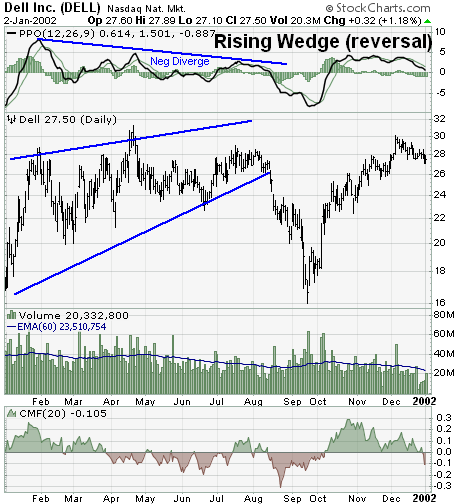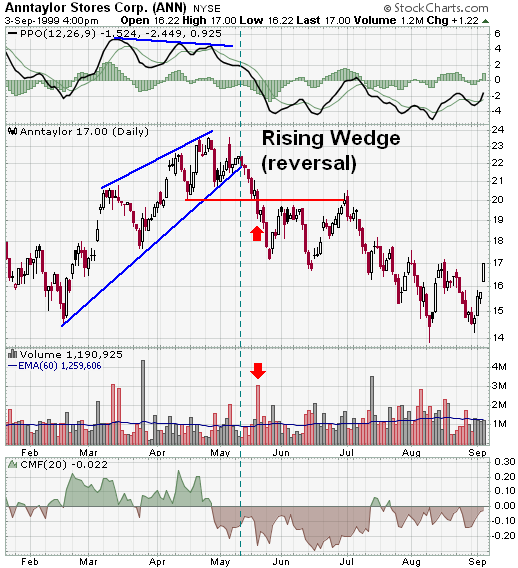Rising Wedge is a bearish pattern that begins wide at the bottom and contracts as prices move higher and the trading range narrows. In contrast to symmetrical triangles, which have no definitive slope and no bullish or bearish bias, rising wedges definitely slope up and have a bearish bias.
While though this article will focus on the rising wedge as a reversal pattern, the pattern can also fit into the continuation category. As a continuation pattern, the rising wedge will still slope up, but the slope will be against the prevailing downtrend. As a reversal pattern, the rising wedge will slope up and with the prevailing trend. Regardless of the type (reversal or continuation), rising wedge are bearish.

- Prior Trend: In order to qualify as a reversal pattern, there must be a prior trend to reverse. The rising wedge usually forms over a 3-6 month period and can mark an intermediate or long-term trend reversal. Sometimes the current trend is totally contained within the rising wedge; other times the pattern will form after an extended advance.
- Upper Resistance Line: It takes at least two reaction highs to form the upper resistance line, ideally three. Each reaction high should be higher than the previous high.
- Lower Support Line: At least two reaction lows are required to form the lower support line. Each reaction low should be higher than the previous low.
- Contraction: The upper resistance line and lower support line converge as the pattern matures. The advances from the reaction lows (lower support line) become shorter and shorter, which makes the rallies unconvincing. This creates an upper resistance line that fails to keep pace with the slope of the lower support line and indicates a supply overhang as prices increase.
- Support Break: Bearish confirmation of the pattern does not come until the support line is broken in a convincing fashion. It is sometimes prudent to wait for a break of the previous reaction low. Once support is broken, there can sometimes be a reaction rally to test the newfound resistance level.
- Volume: Ideally, volume will decline as prices rise and the wedge evolves. An expansion of volume on the support line break can be taken as bearish confirmation.
Rising Wedge Chart Pattern Trend

ANN provides a good example of the rising wedge as a reversal pattern that forms in the face of weakening momentum and money flow.
- Prior Trend: From a low around 10 in Oct-98, ANN surpassed 23 in less than 7 months. The final leg up was a sharp advance from below 15 in Feb. to 23.5 in mid-April.
- Upper Resistance Line: The upper resistance line formed with three successively higher peaks.
- Lower Support Line: The lower support line formed with three successive higher lows.
- Contraction: The upper resistance line and lower support line converged as the pattern matured. A visual assessment confirms that the slope of the lower support line is steeper than that of the upper resistance line. Less slope in the upper resistance line indicates that momentum is waning as the stock makes new highs.
- Support Break: The stock hugged the support line for over a week before finally breaking with a sharp decline. The previous reaction low was broken a few days later with long black candlestick (red arrow).
- Volume: Chaikin Money Flow turned negative in late April and was well below -10% when the support line was broken. There was an expansion of volume when the previous reaction low was broken.
- Support from the April reaction low around 20 turned into resistance and the stock tested this level in early July before declining further.
Source: StockCharts
(Only the headline and picture of this report may have been reworked by the ShareMantras staff; the rest of the content is auto-generated from a syndicated feed.)